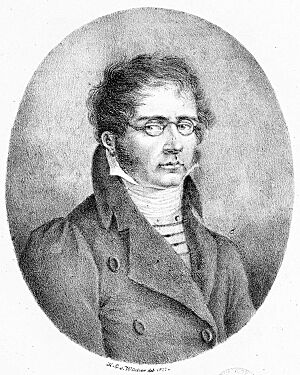Franz Danzi facts for kids
Franz Ignaz Danzi (born June 15, 1763 – died April 13, 1826) was a talented German musician. He was a cellist, a composer (someone who writes music), and a conductor (someone who leads an orchestra). Franz was the son of Innocenz Danzi, who was also a famous cellist. His sister, Franzeska Danzi, was a well-known singer.
Franz Danzi lived during an important time in music history. His career covered the period when music changed from the Classical style to the early Romantic style. This was when much of the music we hear in concerts today was created. When he was young, he met Wolfgang Amadeus Mozart, whom he greatly admired. He also lived at the same time as Ludwig van Beethoven. Like many people then, he had mixed feelings about Beethoven's music. Franz Danzi also helped and guided the young composer Carl Maria von Weber, whose music he respected and supported.
Contents
Life and Career of Franz Danzi
Franz Danzi was born in Schwetzingen and grew up in Mannheim, Germany. He learned music from his father and from another teacher named Georg Joseph Vogler. When he was a teenager in 1778, he joined the excellent orchestra of Elector Karl Theodor.
In 1780, his first pieces for woodwind instruments were published in Mannheim. His father, who was the main cellist in the orchestra, was praised by Mozart for his playing. This happened at the first performance of Mozart's opera Idomeneo.
After Karl Theodor moved his court to Munich in 1778, Mannheim became a smaller music center. Franz Danzi stayed there for a while, working with a small theater orchestra. In 1784, he rejoined the main court in Munich. He became the principal cellist, taking over his father's position.
In 1790, Franz Danzi married Maria Margarethe Marchand, who was a singer and composer. They traveled together with an opera group to cities like Leipzig, Prague, Venice, and Florence.
By 1798, he was back in Munich and became an assistant Kapellmeister. This meant he was a leader of music in one of Europe's most important music cities. However, in 1807, he was unhappy with how he was treated at court. He felt he couldn't advance further, so he left Munich. He became the Kapellmeister in the smaller court of Stuttgart, working for the new king of Württemberg, Frederick I.
After five years, he moved again to Karlsruhe. He spent the rest of his life there at the Royal Konservatorium. He worked hard to improve the music quality of the court.
Franz Danzi passed away in Karlsruhe when he was 62 years old.
Franz Danzi's Musical Contributions
Today, Franz Danzi is mostly known for his woodwind quintets. These are pieces written for five wind instruments. He was very proud of how well he wrote for each instrument in these pieces.
He composed many different types of music, including operas, church music, and orchestral works. He also wrote many kinds of chamber music, which is music for a small group of instruments. Franz Danzi was an excellent cellist. People also said he was a careful and effective leader and conductor of orchestras.
In 2005, the concert hall in Schwetzingen was renamed in his honor.
Franz Danzi's Family
Francesca Lebrun (1756–91), a singer and composer, was Franz Danzi's sister.
Selected Works by Franz Danzi
Here are some of the musical pieces Franz Danzi composed:
- Symphonie Concertante in E♭ major for Wind Quintet and Orchestra (1785)
- 3 String Quartets, Op. 5
- 6 String Quartets, Op. 6
- 3 Duos for viola and cello (book 1)
- 3 Duos for viola and cello, Op. 9 (book 2)
- Wind Sextet in E♭ major, Op. 10
- Septet in E♭ major, Op. 10 (an arrangement of the Sextet, Op. 10)
- Septet in E major, Op. 15
- Sinfonia in C major for Orchestra, Op. 25 (Danzi wrote 8 Sinfonias in total)
- Horn Sonata in E♭ major, Op. 28 (around 1804)
- 3 String Quartets, Op. 29
- Flute Concerto No. 1 in G major, Op. 30
- Flute Concerto No. 2 in D minor, Op. 31
- 3 Quartets for Bassoon and Strings, Op. 40
- Quintet in D minor for Piano and Winds, Op. 41
- Symphonie Concertante in B♭ major for Flute, Clarinet and Orchestra, Op. 41
- Flute Concerto No. 3 in D minor, Op. 42
- Flute Concerto No. 4 in D major, Op. 43
- Sonata concertante in E minor for Horn and Piano, Op. 44
- 3 Potpourris for Clarinet and Orchestra, Op. 45 (1814)
- Concertino, for Clarinet, Solo Bassoon and Chamber Band, Op. 47
- Quintet in F major for Piano and Winds, Op. 53
- Quintet in D major for Piano and Winds, Op. 54
- 3 Wind Quintets, Op. 56
- 6 String Quintets (with 2 violas), Op. 66
- 3 Wind Quintets, Op. 67
- 3 Wind Quintets, Op. 68
- 3 Trios for Flute and Strings, Op. 71
- 4 Bassoon Concertos
- Cello Concerto in A major
- Cello Concerto in E minor
- Horn Concerto in E major
- Ouvertüre in E major for Orchestra
- Piano Concerto in E♭ major
- Sonata in D major for 2 Organs
- Sonatina in D major for Flute and Piano
- Sonata for Clarinet and Piano in B♭ major "Sonata Concertante"
- Sinfonia Concertante in E♭ major for Flute, Oboe, Horn, Bassoon and Orchestra
- 6 Pieces Faciles for Piano, Op. 73
- 4 Arias from Operas by Mozart (arranged by Danzi for 2 cellos)
See also
 In Spanish: Franz Danzi para niños
In Spanish: Franz Danzi para niños


